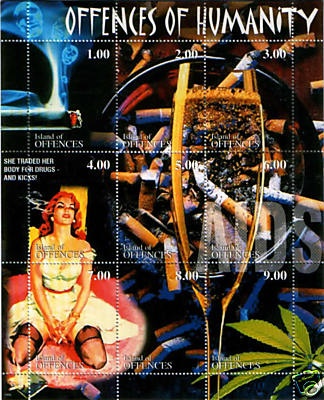Cinderella issues
Cinderella issues are stamp-like labels that are not intended to serve as legal postage. They are often used to communicate a message or to aid in the collection of taxes.
Austria (2005, 2006)
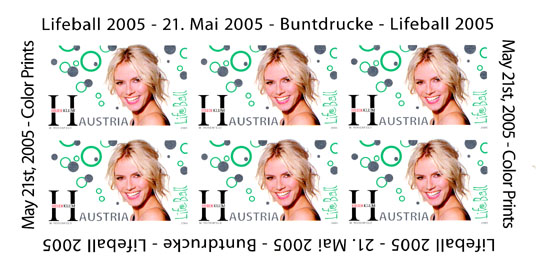

Every year there is a large fashion-themed AIDS fundraiser in Austria called Life Ball. In 2004, 2005, and 2006 the Austrian postal service released commemorative stamps for the event. For a reason I cannot fathom, they also released artistic versions of the 2005 and 2006 versions. These are very similar to the original designs, but as the Austrian postal website makes clear, they are not valid for postage.
Bosnia and Herzegovina (Muslim/Sarajevo administration), 2002
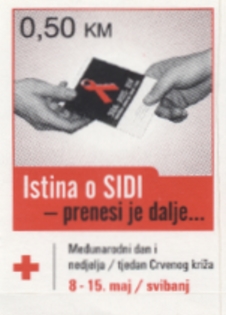
There's an interesting story to this stamp. Bosnia and Herzegovina (Muslim administration) released a similar semi-postal stamp with a value of 0.20 KM in 2002. After purchasing that stamp I found this one from a dealer who said the B&H (Croat administration) postal service released it in 2001. I contacted the ever-helpful Konstantin from Serbian Stamps to help identify this stamp. He explained that the Muslim administration of Boznia and Herzegovina has a habit of releasing parallel tax stamps with a higher value in conjunction to their postal tax stamps.
This is a fancy way of saying the above stamp isn't a postage stamp at all! It's actually a tax stamp used for other services, such as train tickets or admission to entertainment events.
As evidence of this, he was kind enough to send me two sheets from the M&M Catalog, a specialized catalog of stamps from the former Yugoslav Republics. On sheet #1, notice the circled stamp is a 0.20 KM value, much like the 2002 stamp I previously mentioned.
Now look at sheet #2. You'll see a circle around the same stamp in a 0.50 KM value. According to Google translate, the accompanying text reads, "Most items charity stamps had a parallel release of labels, which were used for collecting the contributions of issued tickets and tickets for various events. They are often different from the charity stamps only denominations, which is always higher than those in the marks for the post."
You'll also note on the second sheet has the 2002 version of the above stamp in the top-left.
Lest this matter be so simple, I found a canceled version of this stamp.

This leads to an interesting question. Was the M&M Catalog incorect? Or did someone mistakenly place this on an envelope and the post office dutifully canceled it?
When the Scott Catalog remaked on this stamp, their suggested that it was a valid stamp for charity purposes. They might have been simplifying the matter though.
My instinct is to trust the philatelists behind the M&M Catalog and rule this a cinderella stamp, but it would be nice if I could find an official explanation of what the 50KM stamp was actually used for. We may never know for sure.
Bosnia and Herzegovina (Serb/Banja Luka administration) / Republic of Srpska, ?
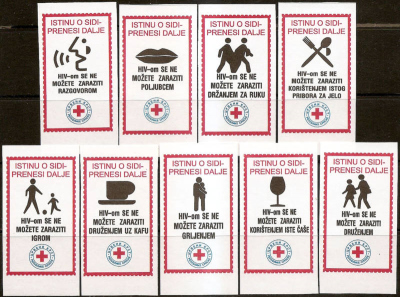
I found this block of cinderellas on eBay. I am still researching them, but Konstantin from Serbian Stamps tells me that they are from the Republic of Srpska (better known in the US as the "Bosnian Serb Republic").
I was initially surprised that they were written in Latin characters as official stamps from the Republic of Srpska use Cyrillic characters, but Konstantin assured me that both character systems are indeed used there. I am currently investigating this set and will add to this entry when I have more to report.
France, July 12, 1995
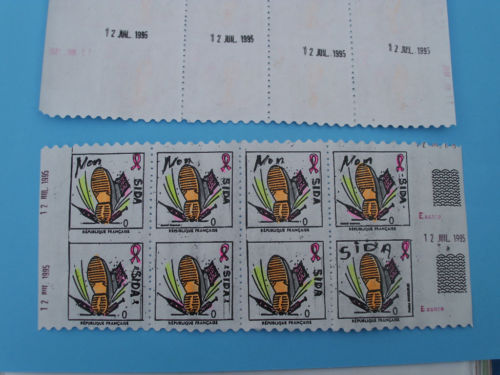

I found this stamp for sale on eBay as being an "unissued private project". An AIDS on Stamp reader in France noted that the stamp is unlike anything the French postal service released in 1995, and is missing most of the markings that all stamps of the time featured. Who made these and what were they for? And if they were just for artistic purposes, why did someone bother to stamp a date on the back? We may never know.
Update: Found two more images, both also postmarked July 12, 1995.

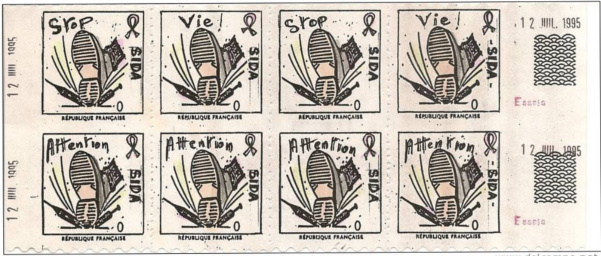
The writing on the green cover reads: "Not a Drug" which may be better translated as "Anti-Drug". The small writing on the bottom of the front cover reads, "Book of Stamps". The back cover says, "initial print run of 100 copies". The location on the back cover says "Region North Pas de Calais", which is the very northern territory in France along the Belgian border. Sure enough, the postmark reads "Pas de Calais".
France, date unknown

This stamp appeared on Delcampe. No further information is available.
Gay Kingdom, 2006

Gay Kingdom is an unrecognized "country" off the coast of Australia in the Coral Sea. It was founded by gay activists upset at a proposed Australian constitutional amendment to define marriage as being for straights only. Gay Kingdom has no regular population and is ruled by a self-proclaimed emporer who lives in Australia. Sadly, Gay Kingdom has suffered setbacks in recent months. The emporer has been deposed, the original website has gone down, and several factions scattered around the world are laying claim to the country. Is war inevitable? Only time will tell.
Island of Offenses, 2000
I have seen this sheet of stamps a number of times over the years, but have never learned who printed them or why. (If you know more, do let me know!)
Lion's Club of Khumalo, date unknown
This cinderella stamp comes up for sale on eBay on occasion. According to the Blair Henshaw Collection, the Lions Club of Khumalo is named after the Khumalo neighborhood in the city of Bulawayo, Zimbabwe.
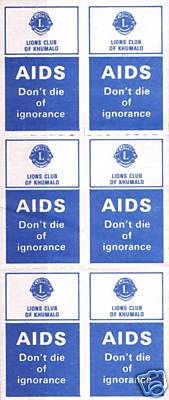
Macedonia, date unknown
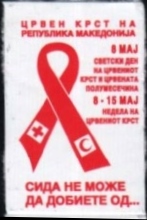
I have only seen this stamp for sale once, and luckily I bought it. At first I thought it was a Macedonian semi-postal stamp, but with further observation I noticed that it was quite different.
- It doesn't share the same dimensions of the other Macedonian semi-postal stamps (and they release a lot of them).
- There is no value printed on the stamp.
- The stamp is adhesive, not backed by gum like the other semi-postals.
- The stamp is dated May 8-15. According to this Macedonian Red Cross page, they release AIDS semi-postal stamps for use during December 1-7.
- There is no year on the stamp. (The stamp was initially sold to me along with a 2008 stamp so I naturally assumed this was from 2008 as well. In retrospect this is not an assumption that is safe to make.)
Sinisa Pavleski from Macedonian Stamps concurs. He thought it was likely a sticker people would wear on their clothes as a part of a community awareness project.
He was also kind enough to translate the sticker. It reads:
Red Cross of the Republic of Macedonia
May 8
World Day of the Red Cross and Red Crecent
May 8-15
Week of the Red Cross
AIDS cannot be gotten from...
What AIDS cannot be gotten from is unclear. The person wearing the sticker, perhaps?
I have sent an e-mail to the Macedonian Red Cross in the hopes they can provide me with further information about this stamp. I'll let you know if I learn anything more from the Red Cross or anyone else.
USA, 1987
This sheetlet promotes the Stamp Out AIDS campaign. According to John Gline's art profile, "Stamp Out AIDS was a national campaign to help people with AIDS. It raised money through the sale of stamps similar to Christmas and Easter seals. The money raised went to AIDS service providers across the country to fund buddy programs, food programs, hospice care, and other vital services. Stamp Out AIDS was instrumental in establishing Broadway Cares, which soon enough became Broadway Cares/Equity Fights AIDS, one of the premiere organizations in helping in the fight against HIV/AIDS."
As seen in this article, the campaign is surprisingly old with a May 12, 1987 mayoral pronouncement supporting the campaign by the late New York City Mayor Ed Koch.

